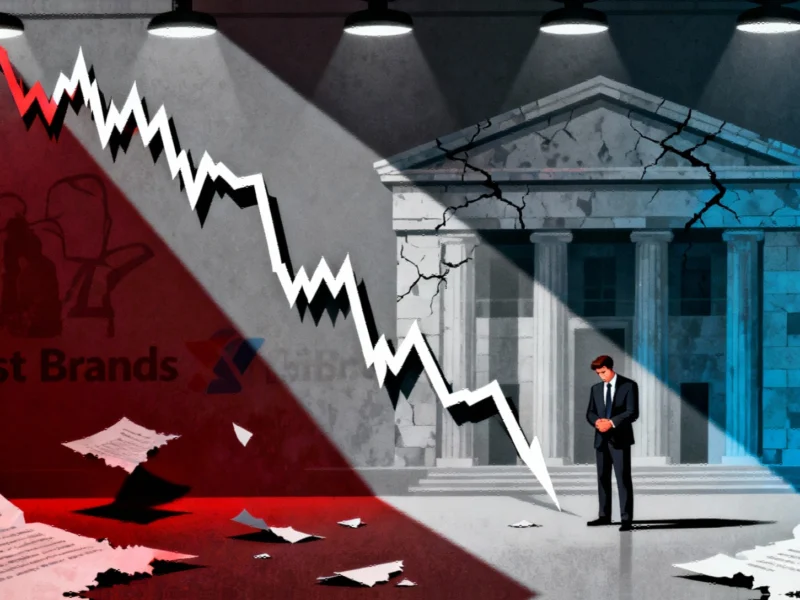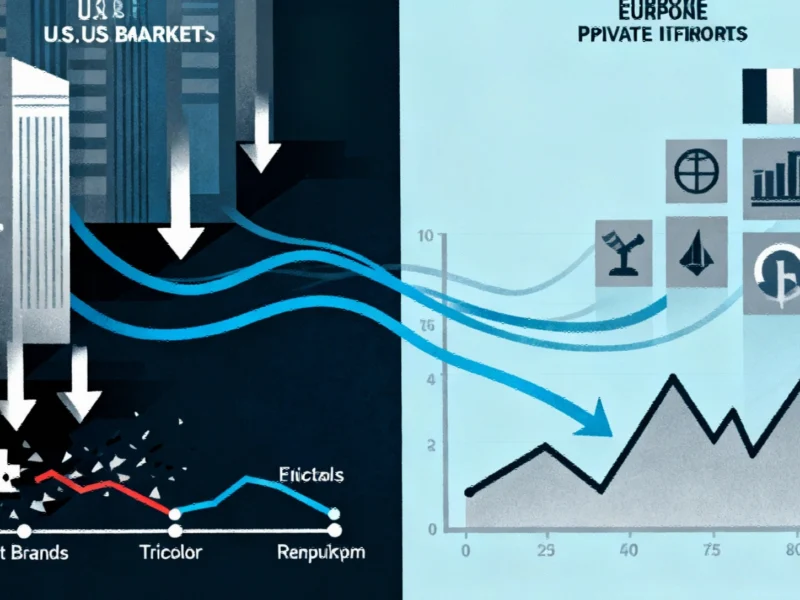TITLE: Regional Banking Sector Rattled by Loan Losses and Fraud Concerns
U.S. regional bank stocks experienced significant pressure Thursday as Zions Bancorporation disclosed a substantial $50 million charge-off related to problematic commercial loans from its California operations. The development has intensified investor scrutiny of credit quality and risk management practices across the sector, with the broader regional banking index declining nearly 4% amid growing concerns about hidden credit stress. This situation echoes similar pressures affecting financial institutions navigating economic uncertainty and elevated interest rate environments.
The market reaction highlights how quickly sentiment can shift in the banking sector, particularly when questions emerge about underwriting standards and transparency. As analysts noted, the optics of a large balance C&I loan to a fraudulent borrower from a bank specializing in small balance C&I loans raises legitimate concerns about risk management protocols. This comes at a time when social media commentary and digital signals are increasingly serving as early warning indicators for potential financial stress points across industries.
Analyst Perspectives on Credit Quality Concerns
Raymond James analysts captured the market’s apprehension in a research note, stating: “The optics of a large balance C&I loan to a fraudulent borrower from a bank that specializes in small balance C&I loans is not great, and puts into question Zions’ underwriting standards and risk management policies.” This sentiment was echoed by KBW analysts, who noted that following the prominent bankruptcies of Tricolor and First Brands, “bank investors are rightfully on high alert for any change in asset quality trends.”
The situation has prompted comparisons to recent high-profile corporate failures, including auto parts manufacturer First Brands and subprime lender Tricolor, both of which have exposed potential gaps in lender oversight. JPMorgan Chase CEO Jamie Dimon reinforced these concerns this week, commenting on anxiety in the credit market and noting that when “you see one cockroach, there are probably more, and so everyone should be forewarned.”
Individual Bank Impacts and Responses
Zions Bancorporation shares plummeted 8.6% in afternoon trading as the bank confirmed it expects to recognize the charges in its third-quarter results and has initiated legal action in California to recover the problematic loans. Brian Mulberry, senior client portfolio manager at Zacks Investment Management, emphasized that “Zions faces the challenge of showing that this is a one‐off event and not indicative of broader supervision or credit control weakness.”
Meanwhile, Western Alliance attempted to reassure investors after its stock initially declined, disclosing that it had filed a lawsuit alleging fraud by Cantor Group V, LLC. The Phoenix-based bank provided additional information about one of its credit relationships and noted that its total criticized assets had decreased since June 30. Despite these efforts, its shares remained down 7.8%, reflecting the broader market skepticism. This dynamic illustrates how global investment patterns and international financial relationships can influence domestic banking sector perceptions.
Systemic Versus Idiosyncratic Risk Debate
The banking sector finds itself divided on whether these developments represent isolated incidents or signal broader systemic concerns. David Wagner, head of equities at Aptus Capital Advisors, maintained that “bankruptcies and fraud are natural in markets, but it doesn’t always lead to something systemic.” Many analysts continue to view the situations as idiosyncratic risks tied to specific borrowers rather than indicators of widespread credit deterioration.
However, the concentration of problematic exposures within the regional banking sector has raised questions about whether certain institutions face disproportionate risk. As Mulberry cautioned, “If further disclosures reveal more losses or related exposures, the risk is that the broader regional banking index — or weaker names — gets re-rated aggressively downward.” This uncertainty comes amid broader geopolitical and economic tensions that could impact financial stability across multiple sectors.
Transparency and Private Credit Market Implications
The recent disclosures have placed renewed focus on transparency within the rapidly expanding private credit market, where complex loan structures and limited public information can obscure risk exposures. Wall Street analysts have drawn parallels between Zions’ situation and the collapse of First Brands, both of which highlighted potential oversight gaps and raised fundamental questions about credit market transparency.
JPMorgan’s experience further illustrates the challenges, with the bank writing off $170 million in the third quarter related to the Tricolor bankruptcy and acknowledging the need to review its controls. Dimon characterized the exposure as “not our finest moment,” underscoring how even sophisticated financial institutions can encounter difficulties in assessing credit risk in opaque markets. These developments highlight why financial leaders increasingly emphasize dialogue and coordinated approaches to addressing market stress points rather than reactive measures.
Market Outlook and Sector Implications
The regional banking sector now faces a critical period where further disclosures could either calm investor nerves or confirm deeper concerns about credit quality. The coming weeks will be crucial for affected institutions to demonstrate that these incidents represent isolated cases rather than symptomatic of broader underwriting or risk management deficiencies.
Investor attention will likely remain focused on any additional credit deterioration signals, particularly within commercial and industrial loan portfolios that have shown vulnerability to economic headwinds and potential fraud. The sector’s ability to maintain investor confidence will depend heavily on transparent communication and demonstrable risk management improvements as lenders navigate an increasingly complex credit environment.
Based on reporting by {‘uri’: ‘reuters.com’, ‘dataType’: ‘news’, ‘title’: ‘Reuters’, ‘description’: ‘Reuters.co.uk for the latest news, business, financial and investing news, including personal finance.’, ‘location’: {‘type’: ‘place’, ‘geoNamesId’: ‘2643743’, ‘label’: {‘eng’: ‘London’}, ‘population’: 7556900, ‘lat’: 51.50853, ‘long’: -0.12574, ‘country’: {‘type’: ‘country’, ‘geoNamesId’: ‘2635167’, ‘label’: {‘eng’: ‘United Kingdom’}, ‘population’: 62348447, ‘lat’: 54.75844, ‘long’: -2.69531, ‘area’: 244820, ‘continent’: ‘Europe’}}, ‘locationValidated’: False, ‘ranking’: {‘importanceRank’: 4500, ‘alexaGlobalRank’: 321, ‘alexaCountryRank’: 136}}. This article aggregates information from publicly available sources. All trademarks and copyrights belong to their respective owners.



